Today at Portland city council our transportation bureau took another step forward in a project that will finally build separated bikeways and other street upgrades in the central city.
“We’re at that moment right now where people are fighting their way through the congestion instead of just realizing it’s going to take five extra minutes to get through downtown because we’re a bigger city now.”
— Art Pearce, PBOT
But before we go any further. Please take a few minutes and fill out PBOT early input survey.
Ok. Thanks. As we were saying…
PBOT’s Central City Multimodal Project finally got the go-ahead from the Oregon Department of Transportation to begin public outreach and planning. PBOT project managers shared a presentation about the project with council members today in advance of formally accepting a $852,000 payment as part of an intergovernmental agreement with ODOT.
Thanks to a $6 million federal grant (via Metro) and $2.8 million from the recently passed local gas tax, Portland will spend $8.4 million, “to help make getting to and around the Central City safer, easier, and more convenient by foot, bike, and transit.”
While the public process for deciding where to put new bikeways, transit-only lanes, new plazas, and so on, hasn’t started, PBOT has already been meeting and making presentations about the project to various city advisory committees and a few select powerful stakeholders like the Portland Business Alliance, the Central Eastside Industrial Council, Travel Portland, and others.
Today at city council we got a peek at how PBOT will frame this crucial project, how council feels about it, and a few more nuggets. Here’s what we learned.
Downtown Neighborhood Association is pumped
While we’re concerned at how PBOT has private meetings with certain stakeholders prior to opening up the process to all citizens, they also use these meetings to line up key early support. Today at council they brought Rani Boyle, the chair of the land-use and transportation committee of the Downtown Neighborhood Association, along to testify on the project’s behalf. And she was psyched.
“We are extremely excited about this project,” Boyle said. She continued to say that many downtown residents don’t own cars and want to walk and bike as much as possible, “but they want to feel safer.” “Too often people have very personal stroies of close calls and injuries… and I’d like to hear less of them.”
Advertisement
PBOT gets it
Watching the council meeting today we were pleased with the tone and framing we heard from two top PBOT staffers: Planning Manager Art Pearce and Capital Projects Manager Gabriel Graff. They have a well thought out and strong case from all the angles: statistics, economics, demographics, planning, and so on.
Pearce understands that Portland is changing and we need to change our streets as a result. Here are some of the comments he made today:
“We’ve been waiting and the constituents have been waiting for this process to get started, so we’re excited to get this underway…
Central cities around the world are re-inventing themselves and the Portland central city needs to think of itself as an evolving place that needs to continue to be competitive with central cities throughout the world…
[This project is a way] to make the central city vibrant and grow and include more residents and employees in a way we can really be proud of.”
And Gabriel Graff gave a short slide presentation (PDF). He talked about the need for improved safety and pointed out that 20 of the 40 high crash intersections for people on bike and foot are in the central city. I also really liked that Graff said the project is just about safer trips, but more trips. One of the best arguments against private motor vehicle use in the central city is that it simply doesn’t pencil out mathematically in terms of space.
Here are a few more of his comments:
“The central city is home to the densest concentration of people and jobs in the state. It’s the region’s economic hub… 30 percent of Portland’s growth will happen in this boundary which has just 3 percent of the land… 37,000 new households, 51,000 new jobs… How can we safely and efficiently get people to these jobs as Portland grows?
We see this project as one of PBOT’s first significant investments in our vision for growth.”
The Biketown effect: Bike share is now a major political force
Biketown changes everything. We’ve been saying that for years and now that it’s here we’re seeing the impacts in real life.
Today Commissioner Nick Fish brought up Biketown on his own accord to share that, “My impression is that the launch of these bikes has been a huge success.” The fact that Fish, completely unsolicited, shared his view about bike share in this context is crucial. Those orange bikes make pushing for bike infrastructure so much easier!
And even Commissioner Amanda Fritz shared a bike share comment. “I’m very pleased it’s working,” she said. But as you might expect, she then added how she’s “very concerned” that many people use bike share without helmets and that, “they continue to ride as other cyclists do on the sidewalks downtown.”
Commissioner Fish, the built environment and behavior change
In the most interesting exchange of the day, Commissioner Fish shared a story about getting flipped off for calling out someone’s dangerous driving while he was walking downtown. “I feel particularly vulnerable in light of the terrible tragedy that recently happened on Hawthorne,” he said.
And then he said,
“It struck me there are limits to what we can accomplish through legislating. We can legislate all we want, but some of the beahviors we’re talking about — cars and bikes observing the laws of the road, stopping at red lights, not accelerating when the light is yellow, putting people at risk — beyond changes in road design and these improvements you’re talking about, what’s missing in terms of getting the message to people that irresponsible and dangerous behavior on our streets is not tolerated? Whether you’re in a car or on a bike?
PBOT’s Pearce had a great and quite interesting answer:
“Portland is at a place in its evolution where we’re growing up as a city and this [bad behaviors] is part of that. We’re experiencimng more congestion and more conflicts as we navigate the streets on a daily basis. Your initial reaction to that is to try and navigate through [the congestion], and that’s actually accelerating those conflicts.
We need to develop a culture where people start to understand that as a city gets larger it takes more time to traverse through the city. We’re at that moment right now where people are fighting their way through the congestion instead of just realizing it’s going to take five extra minutes to get through downtown because we’re a bigger city now.”
(Keep in mind Pearce is saying this to Fish — the man who recently complained about how livable streets projects are making it harder for him to drive downtown.)
“Are we going to win that fight through friendly persuasion or through a bigger stick?” Fish quickly retorted. “What has to happen for us to get people to think twice about their behavior?”
Pearce then mentioned enforcement and informational campaigns, and how biking, walking, and transit infrastructure investments will eventually encourage people to drive less and allow us to “turn the tide on congestion.”
Fish seems to think there are only two ways to combat bad behavior: education and enforcement. What he’s missing is this: the built environment has a large, immediate and direct impact on human behavior. As we build more humane streets, people will behave in a more civil and respectful way.
Our streets will have more “clear spaces”
PBOT also shared a few sketches of what the new street designs will look like. Graff described the designs as having “clearer spaces” that will “acknowledge and reduce all of the conflicts that arise at intersections.” On the newly designed streets every user will have “clearly delineated spaces for travel,” he said.
Here are a few samples from his presentation:
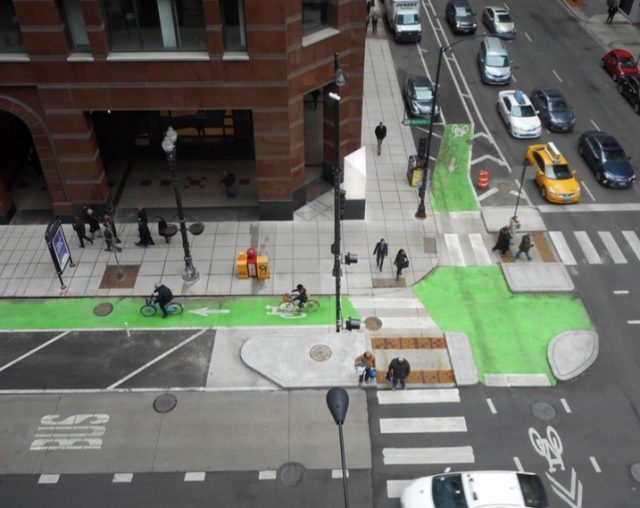
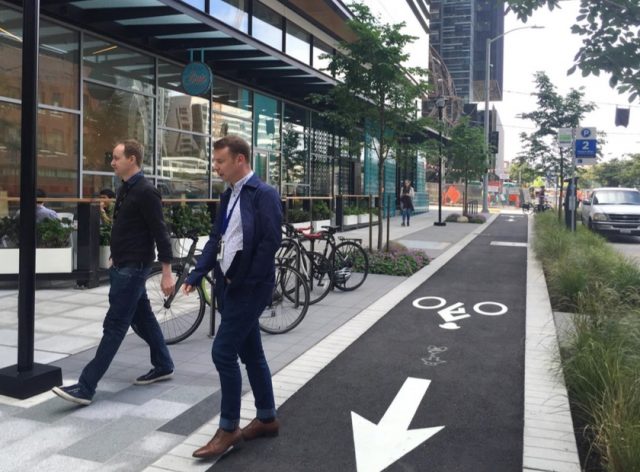
Graff said that this project will continue Portland’s legacy of constantly “evolving” streets. He also showed images of carfree public plazas and the Indianapolis Cultural Trail as an example of how Portland needs marquee bike path projects that will stimulate the economy and engage tourists and locals alike.
The timeline from here is to spend the rest of this summer doing public outreach and forming an advisory committee. Then 2017 will be spent on planning and development and construction will begin in 2018.
Stay tuned. And remember to take that survey.
— Jonathan Maus, (503) 706-8804 – jonathan@bikeportland.org
BikePortland is supported by the community (that means you!). Please become a subscriber or make a donation today.


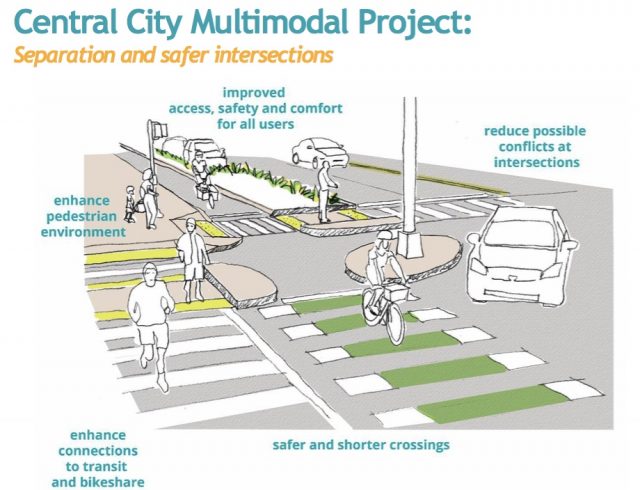
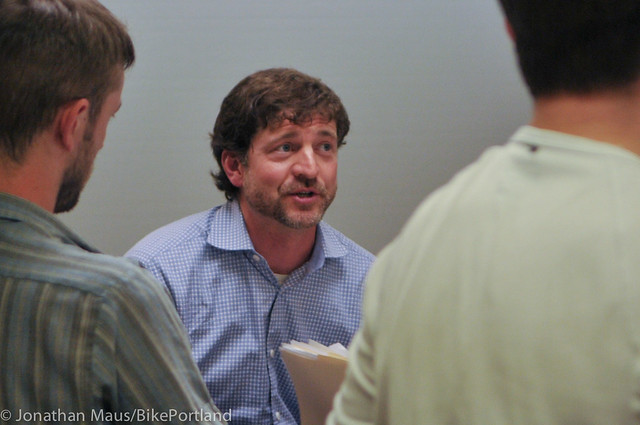
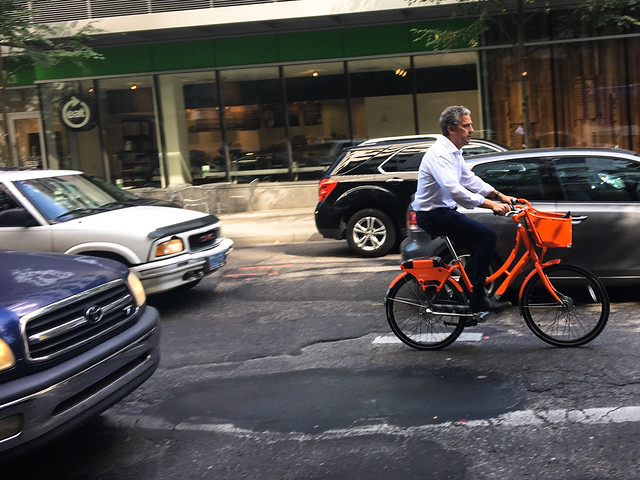
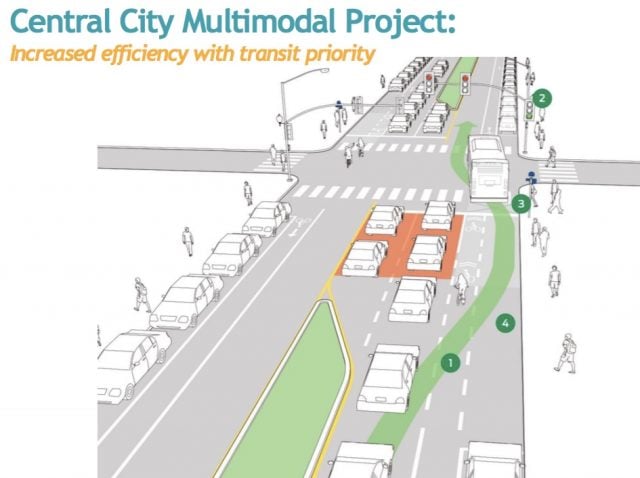
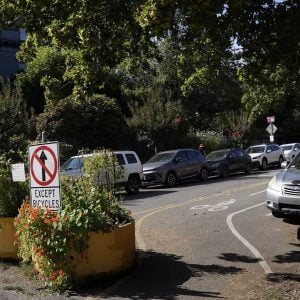
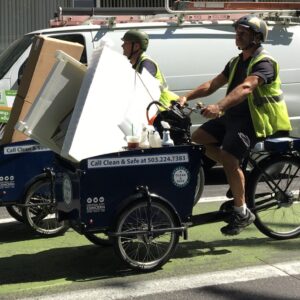
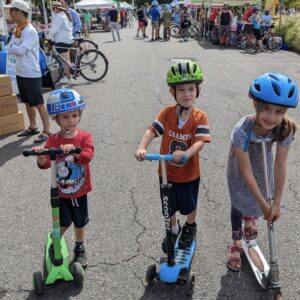
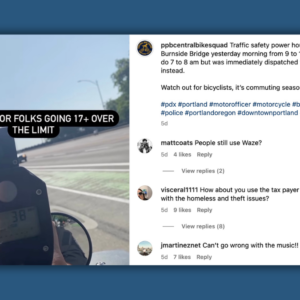
Thanks for reading.
BikePortland has served this community with independent community journalism since 2005. We rely on subscriptions from readers like you to survive. Your financial support is vital in keeping this valuable resource alive and well.
Please subscribe today to strengthen and expand our work.
I saw some green paint that I thought might be part of this work, but after reading the article I think it is way too soon. It was on SE Morrison between MLK and Grand, with a crossbike across Grand leading to ? – maybe the sidewalk on the northside of Morrison? Maybe the crosswalk to head south on the sidewalk along Grand? Maybe to use the crosswalk to access the eastbound lane of Morrison? I cannot figure out what connects to this green paint further west or where it is intended to go to the east. Nay ideas?
when I took the survey earlier (via your twitter) I was pleasantly surprised at how anti-car it was…
(although I wish they had used a term other than “car” to encompass all privately owned motor vehicles)
Sounds much more pro-human than anti-car. It’s not like there’s a goal of zero cars in 10 years or anything.
Fatalities on the other hand?
Thanks PBOT, now start building.
On the other hand, downtown is by far the easiest neighborhood to access without a car, so why aren’t we actively discouraging driving downtown? There are so many other ways to get downtown from anywhere in the metro region, so the closer to zero cars downtown we can get, the better.
See also: Fish and “A to B” about Naito-type projects.
Too many 3-lane one-way roads in downtown.
Yep, and too much cheap parking.
Yes, Downtown is. In stark contrast to the Moody path on the South Waterfront. Things are accessible.
I didn’t see it as anti-car but rather supportive of bikes and other modes. Disclaimer.. Until I see more Jello-Biafra-styled proposals to toll every vehicle entering the core and pay to park on every public street, I don’t see many designs as anti-car..
We designed our streets in the 1960s to maximize speed through the city. If you can drive 60 mph on Barbur why wouldn’t you expect to on Hawthorne? Behavior will change when speed and moving cars as quickly as possible down streets is not the priority.
The “friendly persuasion” Fish is looking for is a bollard here, an extra curb or barrel there, a few jersey barriers getting friendly with your fender if you get too friendly with the accelerator. Drivers need to learn to chill out. If I’m rolling along in my car at the speed of the signal progression, don’t race around me and stop at the red light just to get in everyone’s way and make everyone stop to wait on your car at every block. Watching somebody walk across the street or roll past on a bike isn’t going to change how long it takes the light to turn green. If you want to feel the wind on your face, get out of your car.
Walking with the signal in a crosswalk, I got a driver turning left out of the bus lane looking at me like I need to get out of his way because he’s a moron for driving in the bus lane and there’s a bus coming. How can he even mention bikes in the same sentence as this BS? Somebody on a bike isn’t going to hit you without taking at least equal damage themselves, just keep walking. Maybe Fish gets startled because he didn’t hear the bike coming? I see a lot of problems with that no-look stuff from drivers. Maybe ride a bike to work?
Totally! I don’t run into stuff on my bike or walking, because it hurts, on the streets, or on trails. It doesn’t do me any good to crash. The driving environment needs financial ‘discouragement’ to prevent bad driving. I am careful as hell driving around bollards because I don’t want to pay to fix body damage on my car.
I think it was a driver he complained about, not a cyclist.
Glad to see this work finally starting and that there will actually be sufficient funds allocated for it, so that unacceptable compromises won’t have to be made. I also like that PBOT is focusing on protected intersections. There is way too much space allocated for cars downtown, and this results in, predictably, too many cars downtown. Taking space away from cars to build protected bike lanes is a good start to fix this problem.
I hope #1 on the list for this project is fixing the west side Hawthorne Bridge approach/landings. You’d be hard-pressed to find a single cyclist in Portland that doesn’t think that area needs fixing.
I am afraid that this will end up like the South Waterfront and Tillikum Crossing. Over engineered, confusing, multiple signals for different modes of transportation, senseless light timing, poles obstructing views..
They must have learned something from that, right?
…right?
…
…
…right?
You mean the west-side path on Moody? That’s the best cycling facility in the city. We should be copying that design for downtown, rather than looking at it as a mistake to learn from. Only change I’d made is ditch the two-way design in favor of a one-way, and make the lane and turning areas wider.
You must be joking. That area is overengineered, slow, confusing as all heck, and has peds, cyclists, transit, and others in each others’ way. When the traffic is not all mucked up, I sometimes choose to ride the road with the tracks because it’s a better option than that mess.
I am not joking. I love it because I never have to interact with a single car for the entire stretch and each mode has its own traffic signal phase. There is also a floating streetcar station so I never have to interact with transit vehicles.
Don’t forget the driveway and the jug-handle at the south. Moody is ok in the places where it doesn’t have to try very hard, but so is Barbur.
It is true you don’t have to interact with a single car. However, crossing Moody by Tilikum is mucked up no matter how you look at it.
The cycle path consistently gets blocked by riders needing to cross Moody both near Tilikum bridge and the tram because there’s no place for them to wait, and the light cycles are short enough you might not even get across if you have a few slow pokes in front of you. The timing of lights is such you can wait a really long time to cross again, especially when buses and trains pass and it often seems like everyone is waiting for nothing.
Meanwhile, a cycle light on the path across Tilikum turns green while the actual light on Moody is still red causing some to jump the gun and go out into traffic, if you cross from Tilikum onto the cycle path, you wait for a red light only to consistently get another one if you continue South, and then the red lights on the bike path stay on forever while nothing his happening. Some cyclists try to avoid the double red light, but this puts them going the wrong way which makes it only more confusing. In addition, you have peds wandering onto the bike path near the stop.
A fairly good indicator that this area is messed up would be when they first got it going, they had extra signs and live people to help make people do the right thing — anyone who doesn’t go there regularly will see signs, paint, people, and lights all over the place.
I honestly don’t find the signals to be a problem. If the worst thing I have to deal with on my ride is a long red light, I’d consider that a success. Signals can always be re-timed, and I would much rather have a fully-separated cycleway free from motor traffic than be passed by drivers every 30 seconds on a half-assed “greenway” that still allows full auto access.
That says nothing about the door zone lane south of the Tram. That lane is indeed crap.
And the please walk your bike area near the gondola complex. It’s all fairly anti-bike and out of touch.
I agree. It is clear the designers’ hearts were in the right place, but it is one confusing set of infrastructure. I’ve never driven there, so I don’t know how it works from a car’s POV, but for cyclists, it’s a bit of a maze.
I am the person who has a problem with like 99% of bike infra in this town and I have literally never found the Moody cycleway to be confusing or unsafe. I think that should be a statement of success in of itself. 😉
That’s because it’s clear the big design priority was to separate every mode of transit and give each dedicated areas and lights — and that’s consistently been your thing.
I’m not generally a fan of door zones, but I must say that’s my favorite part of Moody now — it’s the only place where cycling is kind of like riding a bike.
“Separating every mode of transit and giving each dedicated areas and lights” is how we get to huge mode shares. Clearly the 93% of people not currently cycling for transportation in this city are not jumping at the opportunity to ride in mixed traffic. Go look at any city that has a large percentage of people cycling and you’ll see this is how their infrastructure is organized.
Amsterdam has very few traffic lights because they largely avoid intersections where cars and bikes need to wait on each other — and the big unavoidable ones are better handled with grade-separation and/or roundabouts. Their key trick though, appears to be simply closing roads and/or intersections to cars. It’s quite clever and cheap.
Cars are fairly predictable, pedestrians don’t have lights that indicate when they want to turn or go backwards, they use the bike path like more sidewalk. They gawk at the gondola and wait for the streetcar behind those floating streetcar stations.
On the subject of streetcars, the bike signal (feels like separate but equal to me, and not even equal) is often red when the road has a green light, or red when the streetcar is merely turning on or off of the bridge and there is not a max or bus in plain sight for quarter mile in either direction.
To force people to use it, they even put a “No Bikes on Roadway” sign on that little stretch between Sheridan and the Gondola, which gets clogged up by the streetcar, max and bus signals anyway!
Honestly, it was ambitious, it represents a good commitment to funding, but a really poor understanding of the needs and wants of a cyclist. I think I understand why you support it, but it is not functioning.
Jonathan, you said it with other words, but I’ve been saying the same thing when people say “education and enforcement”: the street design educates every user, and enforces a particular behavior, every time it’s used. Because this education and enforcement is constant, it’s way more effective and persistent than traditional understandings of those concepts. The problem is we have for years designed our streets to send conflicting messages than what our laws and our public safety campaigns say. It’s time we reconfigure our streets to be in accord with our intentions.
Excellent news. Certainly matters to keep an eye on in the coming months and years.
BikePortland publishers: my good friend Rani Boyle is too modest to request a spell-check on her name in this article, but I’m not. Thanks.
Thanks Ben. Fixed, and apologies to Rani.
Fritzers gonna fritz. Complaining about sidewalk biking without helmets during discussions about cars running over people should be called fritzing.
“Fritzing” — I love this.
All well and good. But what’s the plan for keeping the clueless and feckless from using protected bike lanes as a VIP walking route, as so well documented in NYC by Bike Snob and even shown right here in the Seattle photo?
Lotsa bikes in the bike lane, hopefully.
A well-timed dinging of a bicycle bell.
Lots of people live in their own world, can’t hear because of headphones, or might even be hard of hearing.
One thing I’ve noticed in general is that cyclists get a lot closer to peds in this town than they should.
Looking at the first drawing I just want to vomit. Really. I see a hazardous, narrow (in terms of capacity; plan to fail?) door-zone bike lane that uselessly curves to an “out of sight, out of mind” zone at the intersection. Negative bonus points for cyclists having to simultaneously manage door zones, pedestrians and hooks all in twenty feet, all from different angles and all with minimal sight lines. This feels safer to someone? Good grief.
I can fully vouch that Chicago’s buffered bike lanes are crap. However, a well-designed cycleway that is fully signaled and is not obscured by parked cars can vastly improve safety and cycling rates.
‘fully signalled’ just means that cyclists are going to have to wait forever for an extremely short green light. No thanks, I’ll just take the lane and proceed with the motorists.
The signals can be timed to prioritize cycling, as is done in the Netherlands. At any rate, it’s not as if I’m in a hurry, and I’d much rather be slowed down by a red light on a car-free cycleway than be passed every 30 seconds by an impatient driver on a greenway.
As if those were your only choices; I can ride downtown, not quite as fast as I’d like to, but close; I’m rarely passed (not that I really care), and I feel that I’m on an equal footing with other road users.
And I find riding downtown to be extremely stressful – even on the green lanes on Oak/Stark. I often ride on the cross mall and often have people drive onto the MAX tracks to pass me. To each their own, I suppose, but I remain extremely doubtful that downtown’s current free-for-all will attract the kinds of cycling rates we hope to achieve.
Probably the only thing that you would not find stressful is if autos and trucks and buses were simply banned from downtown. That would be a cycling paradise, but I suspect there would be unintended consequences.
Car-free downtown would be wonderful, but I will also accept neighborhood-wide fully-signalized cycleways. Downtown could most definitely have less cars though, and I’d start with implementing $20/hour parking rates. We need to remove the temptation to drive downtown and encourage people to take other modes. Parking is free at the MAX stations outside town…
I disagree that they put cyclists “out of sight, out of mind”. The protected intersection is specifically designed to put cyclists in a more visible position for turning drivers. Sure, you can be more visible by taking the lane and riding in mixed traffic, but most people are not comfortable doing so and would prefer separated facilities.
Are you talking about the first drawing, or the picture from chicago?
The main thing I see wrong with the first drawing is that it’s the “standard dutch junction”, which we’ve never built and apparently nobody has. http://www.aviewfromthecyclepath.com/2014/02/the-myth-of-standard-dutch-junction.html – “Where cyclists do have to use the same junctions as drivers, they are often provided with simultaneous green traffic light designs (the safest and most convenient option) or roundabouts.”
See how many of these you can find in Amsterdam? https://goo.gl/maps/di6ocSdNjVN2
Places that actually look like our downtown, there are no turns for cars. Door zone bike lanes and 18.6mph speed limit, yeah. But if you want to get off of this street in your car, you have to go 1 mile out of your way. And the single auto lane in each direction is 8ft wide.
https://goo.gl/maps/2zvgMKZDETu
https://goo.gl/maps/2diCoM4DiJs
How could we make 2-3 lanes of 11ft-wide car traffic with parking on both sides and intersections every 264ft more people-friendly? I think that’s the question we’re trying to ask here? Must be one of those things where when you finally ask the right question, you already know the answer.
Meanwhile, there’s lots of time between now and 2018. Let’s just close every street which isn’t named after a president or divisible by 3 to through auto traffic until then.
Funny that they take their inspiration only from U.S. places — at least in these two pictures. What about Amsterdam or Copenhagen? http://www.copenhagenize.com/2016/08/three-design-elements-for-safer.html
I love the parked box truck encroaching on the bike Lane in the first rendering
Why do people keep calling the photo from Chicago a rendering? That’s a real photo and has already been installed.
It looks to me like I am seeing just a bit of what I’ll call advocacy capture. PBOT wants to do certain things, particularly segregated infrastructure, whether it would improve facts on the ground or not. Many advocates want to maintain positive relationships with insiders, so they don’t question bad plans because that will cost them access. Excuses for failure are accepted and amplified. Alternative approaches that have been successful elsewhere are dismissed, especially when they would involve defunding PBOT in order to adequately fund traffic law enforcement.
And let’s not forget that the entire process is done outside the general public’s prying eyes by insiders, which is also barely mentioned. End justifies the means? Even when good people are the ones engaging in corrupt practices, it still smells like corruption.
Finished! thanks for posting the survey. I wouldn’t have known about it.
One thing that Mr. Fritz does not seem to consider: infrastructure also influences norms about how we can / should drive. I notice that myself the few times I still use a car: when I am on MLK, say, with it two lanes of cars each way, no bike infrastructure and pedestrians pushed to the side, I am put into a position of power by infrastructure, which tells me that the car has priority here. Totally different on SW Moody / Tilikum, with the buses, bikes etc.
I’m guessing you meant Mr. Fish, not *Ms.* Fritz.
@ Amanda Fritz. I’m a sidewalk rider when the roads/ speeds/ aggressive driving creates an enormous Sh__show of danger. I’d rather survive than get mowed down by oblivious semi trucks and tourists. Stop obstructing and start leading!
I don’t feel the need for elaborate protected infrastructure downtown. I ride my bike there daily, and don’t want to be funneled into some narrow corridor with no way to pass slower moving bike traffic, and little room to maneuver around distracted or clueless pedestrians or other obstructions. I will be very sad if bicycling is no longer an efficient and flexible transport option.
I do feel the need for elaborate protected infrastructure downtown. I also ride my bike there daily and although cars are limited to 15 mph, it’s still not pleasant being surrounded by cars and trucks everywhere. All the issues with protected infrastructure you listed can be easily solved. No one is mandating the bike lane be narrow – a proper cycleway should be at least 8 feet wide to accommodate people cycling side-by-side and wider cargo bikes. Protected infra attracts more riders, and a cycleway full of cyclists serves as a great deterrent to people walking into the cycle lane.
If we want fewer people in cars and more people on bikes, we need to create bicycle infrastructure that suits the needs of those who aren’t riding right now, and that includes slowing EVERYONE down. If you look at cycling speeds in high-cycling-rate foreign countries, the cyclists they are more similar to pedestrians and the infrastructure more similar to sidewalks, while in low-rate countries, they’re more like cars and the infrastructure more like car lanes.
Excessive speed undermines safety, but it does not follow that slower is always better.
I would prefer if downtown traffic moved a faster point of view. Not just for getting from point A to point B in less time, but because I think it would actually be safer.
Except when there is only one travel lane in each direction and no bike lane, I really don’t like traveling in heavy traffic that’s moving at the same speed that I am. When this happens, it’s easier to be in blind spots, there are fewer visual cues for both drivers and cyclists, and you often have less reaction time than if they’re going faster.
You’d think it would be better for bikes to go faster than cars, but my experience is that things actually work best if the cars consistently move a little faster than the bikes.
Will we finally get a northbound bike lane downtown? At this point even a substandard tiny stripe of green paint would be better than nothing. How is it that there are southbound bike lanes on several streets and none at all in the other direction? Do they think cyclists ride into SW and then just.. disappear?
I think it’s an uphill/downhill kind of thing. The only reason for a bike lane heading north is to slip past traffic when it’s congested. The downside is that you’d be legally required to ride in that lane (imagine riding in the bike lane on Broadway, only downhill at much faster speed, and it should become clear why that would be a disaster).
The only way it would work, I think, would be to do a Stark/Oak style of full-lane bikeway, but given traffic volumes and turn volumes, I really can’t imagine it working on any of the streets where I ride.
So I for one am glad there are no northbound bike lanes. Take the center lane and enjoy the ride.
Or we could just ban cars from the bus mall and make the auto lane a bike lane.
Cars were banned for many years. I don’t remember why they rescinded it. I also don’t remember if there was a bike lane there, but I am certain I used to ride on it frequently.
They reminded it because businesses complained that lack of car access was hurting their bottom line. Never mind that there’s basically zero parking on the bus mall to begin with…
It has nothing to do with parking; the businesses want people driving by to remember they exist; they want drivers to be able to drop passengers off nearby. We tried it long enough for the initial panic to have passed. Maybe it really did hurt the businesses to restrict auto traffic.
The street is neither a good place to walk nor ride, so I don’t lament the changes.
The bus mall is great for walking. It has the widest sidewalks pretty much anywhere in Portland.
And it’s loud and smelly, and doesn’t have a lot of interesting destinations. To each his own, I suppose.
TriMet could definitely use more than four all-electric buses.
Bikes were banned also, until the auto lane went in. PPB used to ticket cyclists for riding on the bus mall.
Okay, so ban cars but not bikes.
But the coppers never managed to take down Hello, Kitty!
There is nothing wrong with cars on a street as long as they are in their place. Buses, cars and bikes. Have them all.
Basically every single avenue downtown has room for a protected bike lane. Why do we need three lanes of motor traffic every 200 feet? 2nd, 3rd, 4th, Broadway, and 12th should ALL get protected bike lanes. Ban driving on the bus mall as well as the streetcar lanes on 10th and 11th. So much of downtown is given over to cars, it’s maddening.
You don’t need a protected bike lane downtown. That’s why it’s such a great place to ride!
What fantasy version of downtown are you riding in that you would consider “great” for cycling?
I like your style.
You are so right. My 6 year old is really missing out dicing it up with traffic. My wife and mother and law too.
“That’s Amsterdam” was my first thought HOWEVER the key difference is there each mode gets its own lights/signals. Each mode gets a time to do their thing or they get a good head start. Until we address giving each mode their own portion of the light cycle and invest in more sophisticated signaling I don’t think we’ll see fewer conflicts (i.e. crashes, deaths, run ins, injuries).
Adam has apparently never seen a cycle path he didn’t like, no matter how poorly designed and unsafe it is.
I say let the City build all of this crap that they want, AFTER the state has repealed the mandatory sidepath law (ORS 814.420).
No, I like SW Moody, as well as lots of cycle paths I saw while in the Netherlands.
Then please move there. Just because you are so freaked out by just the thought of riding near a car doesn’t mean everyone else shares your fear.
Considering how only 7% of people commute by bike in Portland, I’d say that actually yes, most people do share my view.
How does that follow? What evidence do you have that the majority of people would commute by bike if not for their fear of cars?
See Roger Geller’s “Interested but Concerned” research. At least 50% of people fit this category.
is there a proposed or best ideas map of which streets will be for biking? I have ridden downtown for years on my own. But we tried the biketown last week and I had a few new impressions. First, my sense of safety dropped measurably riding with my kids. Waaaaaay down. Paternal instinct I suppose. Second, nobody has a clue what roads are better or worse to ride. There are a lot more bikes mixing with the traffic and peds, which is a good thing. But the ensuing confusion could use organization and direction for all users PRONTO.
2018 seem so far away.
There was no through bike lane. Bikes could use sections of lane not restricted for buses only but there were intermittent blocks where it was a violation to go through. Same ticket as running a stop.
The photo of the guy on the bike share on that road…looks downright 3rd world. If I had to ride on a road like that, I would ride on the sidewalk as well.
The PBOT Bicycle Lunch and Learn will focus on the Central City Multimodal Project this month. Hear presentations from Gabe Graff and Mauricio Leclerc – and bring your questions (and your lunch). Thurs, Sep. 15, Noon at City Hall (click my name for the Facebook event).